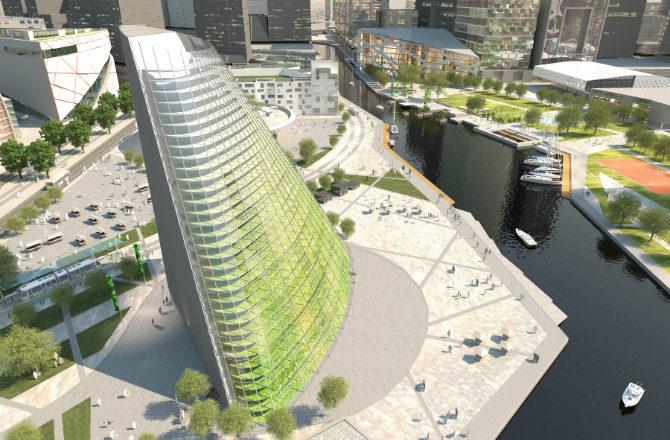
Designed for Linkoping, Sweden, this 177-foot vertical farm features crops grown on spirals that run down the building. Crops move downward over the course of two to three months and are then harvested at the bottom.
Flourishing green skyscrapers are sprouting up, both literally and conceptually, around the world. With the world’s population on target to grow by some 2.5 billion people by 2050, according to the United Nations, 80 percent of those people will reside in cities, which will challenge agriculturalists and designers alike to accommodate the increasing need for vertical epicenters.
We are used to offices and apartments going up, but in the future, we could also see farms. Some of the most innovative developments tout everything from special LED lighting to so-called farmscrapers that simultaneously nurture crops and clean smog.
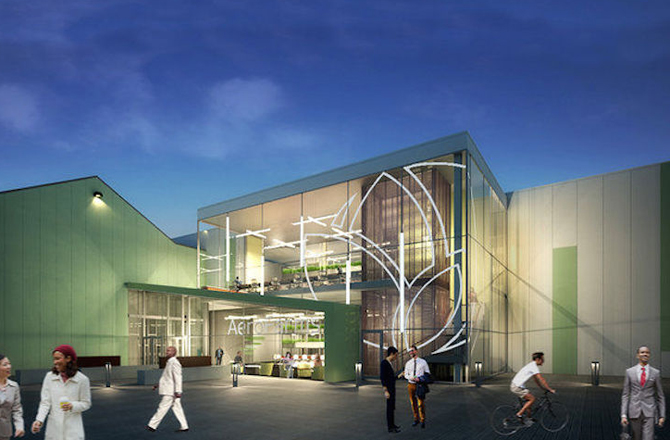
New Jersey, the Garden State, is about to live up to its nickname. A new $30 million vertical farm is being built as part of a ‘Makers Village’ redevelopment project underway in Newark’s Ironbound neighborhood. Once built, the 69,000-square-foot facility will not only serve as the headquarters for the agricultural firm AeroFarms, but it will also be the world’s largest indoor farm, capable of growing two million pounds of soil-free leafy greens and herbs each year. The farm will run partly on solar power, use recycled water, zero pesticides and fertilizers and create about 80 jobs.
From our partners:

The world’s largest indoor farm in Japan produces 100 times more vegetables per square foot than other farms. Shigeharu Shimamura, the designer of the vertical farm and founder of his company Mirai, which means “future” in Japanese, worked in collaboration with General Electric to develop a special LED lighting system. Mirai then implemented towering rows of thin soil trays. The facility uses exact measurements for temperatures, humidity, light and darkness and cuts food waste by 30 to 40 percent.

A conceptual future is filled with flourishing green skyscrapers to help clean smog from the air. Paris City Hall commissioned Vincent Callebaut Architectures to devise a plan for Paris in the year 2050 that would reduce the city’s greenhouse gas emissions by up to 75 percent. The project, called Paris Futuristic 2050 Paris Smart City has farmscrapers” made of vegetable towers that filter the air and encourage food production to happen locally.
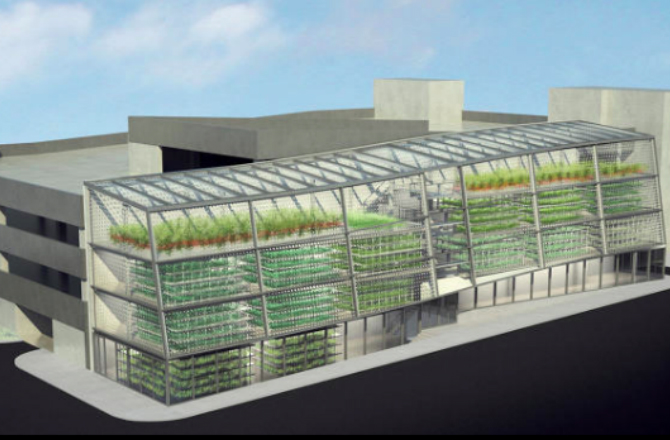
Jackson, Wyo., is on a path to become home to three-story farm. A company called Vertical Harvest has unveiled plans to create a greenhouses filled with microgreens and tomatoes. The plants will move throughout each greenhouse floor on a conveyer belt, getting an equal amount of time in natural light on the south side of the building.
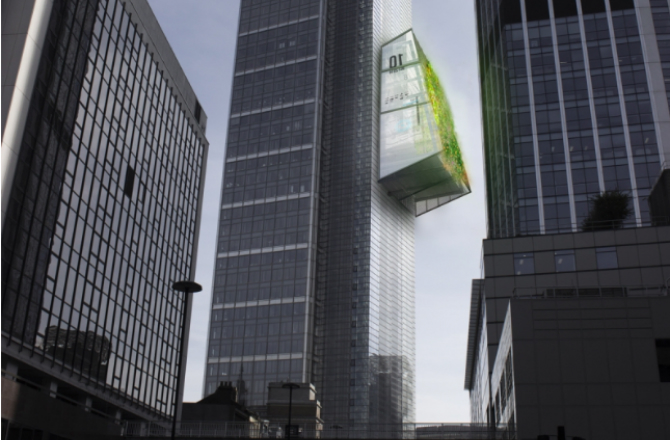
Imagine an office where you can visit “sky gardens” and planting stations for a quick breather, or better yet, to harvest your own food while putting in long working hours? Interior designers Sean Cassidy and Joe Wilson’s innovative vertical farm concept called Organic Grid+ features just that, along with wearable technology to track individuals’ health and suggest appropriate meals to improve morale, concentration and productivity. The concept recently took top honors in the Workplace of the Future 2.0 competition.
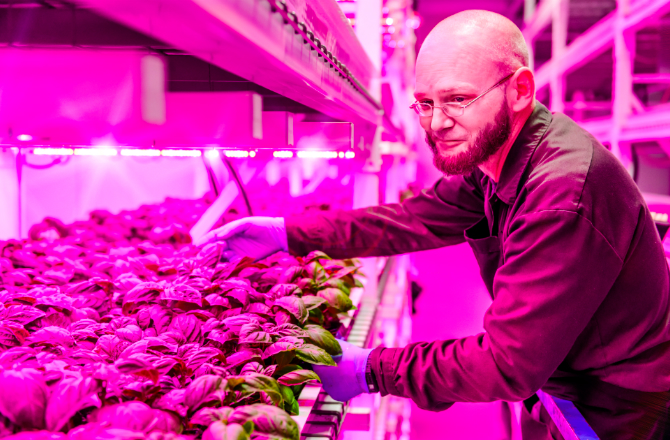
Green Sense Farms, based in Portage, Ind., grows microgreens, leafy greens and herbs in 25-foot-tall carousels. Light from 7,000 LEDs, provided by Dutch technology firm Royal Philips, gives the plants energy. Because of the efficiency of the LEDs, Robert Colangelo, founding farmer and president of Green Sense Farms, and his team are able to plant crops in closer proximity than if they were grown outside.
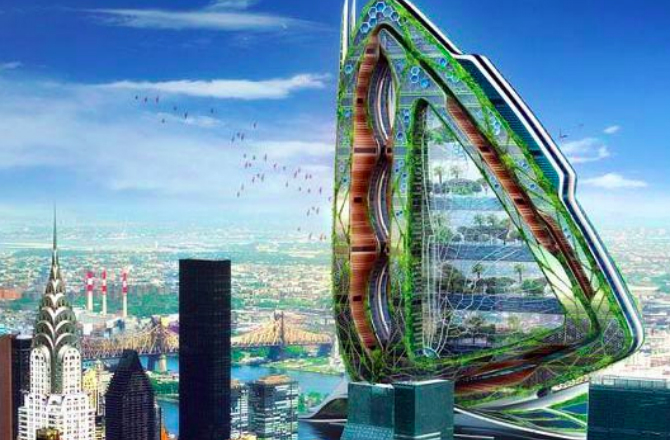
In another concept created by Vincent Callebaut, this urban farm was designed with New York City’s Roosevelt Island in mind. The vertical farm concept called Dragonfly would accommodate 28 different agricultural fields to produce fruit and vegetables, along with meat, dairy and grains.
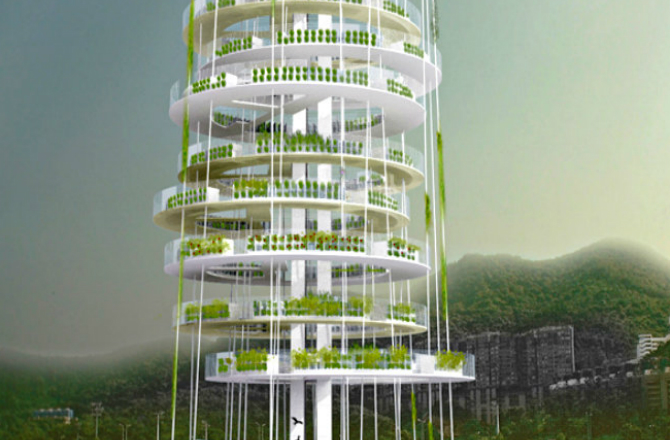
To help support local food production in China, Spanish firm JAPA Architects proposed a concept called Dynamic Vertical Networks, or Dyv-Net, that would be located close to city centers and would produce crops vertically year-round.
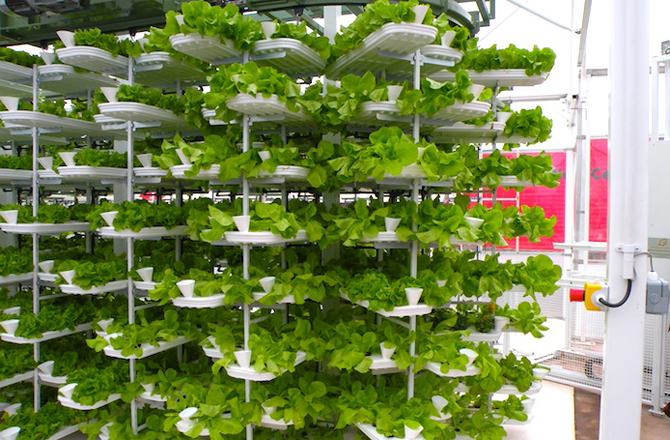
Vancouver-based VertiCrop loads plastic trays with up to 50 varieties of leafy green vegetables to produce as much food in a 50′ x 75′ area as a 16-acre farm would. The technology requires only 8 percent of the normal water consumption used to irrigate field crops.
This feature is adopted from Discovery News














